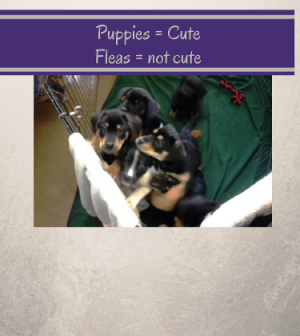- Do you subscribe to Dharma Dog Training’s Newsletter? You should.
- A Unique Campaign from The Humane Society of the United States
- Rabid bats in Omaha- Stay safe, prepared with these tips
- Springtime Activities in Omaha
- Mill Dog Monthly from Bailing Out Benji
- World Spay Day, Legislative Alert in Nebraska
- Attend the Nebraska Rescue Council’s monthly meeting this Saturday
- Five Hard-to-Ignore Reasons to Adopt!
- Paws in Pink to Benefit Breast Cancer Foundation
- VCA, Inc. Acquires MidWest Vet Specialists from Kansas State University
It’s the height of flea season. Be prepared!

We’ve recently read a few articles on the prevalence of fleas that inhabit your pets and found some notes worth remembering. Flea collars help ward off fleas, but one article highlights the possibility that some flea collars make dogs sick. Another tells us that, even in cold weather, fleas can find their way to your pet’s body. We have some advice for you and even an alternative to traditional flea collars that is safe for your pets.
The Forum, a publication in the Fargo, ND area, has an “ask the vet” feature that often elicits some great questions and answers. Dr. Fox, a local vet, takes and answers questions from the public. One reader wrote in recently to ask about his dog who apparently had a healthy life up until he started wearing a certain flea collar. It turns out that the collar had caused seizures in the reader’s dog and the health problems that suddenly appeared are no surprise to Dr. Fox.
“The drug companies selling these flea collars and others selling spot-on chemicals to kill fleas are an abomination,” Dr. Fox said. “Many environmental health experts link these kinds of pesticidal products to cancer, and a host of other products from the big pharma multinationals cause more harm than the fleas themselves.”
What we’ve learned: when buying flea collars, check to see where they come from and whether they are using chemicals and pesticides to ward of fleas. Pet Protector, a chemical-free, non-toxic, water resistant and safe product is a good alternative to consider. To learn more about Pet Protector, go to http://www.midwestpetprotector.com/.
As we said before, fleas are usually thought to become more of a problem in warmer months, but a recent article indicates that they can show up even in the coldest of conditions. Pantagraph.com publishes a similar Q & A article, like the one from Fargo, and a reader recently wrote in about her inside cat who has taken to licking her fur so much that she has completely removed it. After visiting the vet, flea dirt was found on the skin, even though it was, again, an inside cat in the middle of winter.
Dr. Tim Anderson had this response for the reader which is very informative to all cat owners: “Having fleas in the middle of winter is not an unusual thing for veterinarians to see, so I am not surprised. What you need to consider is that your cat didn’t just get the fleas; he has actually had them for a while, in most cases at least a couple of months. The initial flea or fleas could have easily come inside on someone’s clothing or on another pet such as a dog that goes outdoors.
What you are dealing with now is the second generation of fleas that have become adults. The initial female flea or fleas were laying 20 to 50 eggs every day, with those eggs then falling off of your cat into the environment of the home. The flea life cycle takes three to five weeks on average to complete, and can take up to eight or 10 weeks.
The main reason that you haven’t seen any fleas is that cats are tremendous groomers of their haircoats. Any flea that a cat can reach will be consumed, but in many cases those fleas may have laid many eggs prior to their death, which just starts the cycle over again for the next generation. Any evidence of flea dirt (which is actually the flea poop made up of digested blood) confirms that your cat has fleas.
At this point you need to concentrate on treating your cat with whatever medication your veterinarian recommends. This can be a topical or an oral medication and will be extremely effective at killing any adult fleas that get onto your cat. You need to do at least one treatment a month for the next three months to ensure that all adult fleas in the home are dead. More importantly, you need to treat your house to kill the flea eggs and larvae. There are many products that you can use to do this; I prefer what is called an area treatment spray. This is an aerosol canister that you can directly spray onto your carpet and other surfaces where flea eggs and larvae may be. Do at least two treatments throughout the house and make sure you get all of the hard-to-reach areas, such as under chairs, couches, coffee tables, etc.”
Even though it might be an extremely cold winter, be aware that fleas your animal may have could be from warmer weeks and months ago. Pay attention and be diligent in your animal’s treatment. Now could be the time to prevent fleas from popping up in the fall and winter months. Our best advice: seek the counsel of your veterinarian to determine the best course of action concerning prevention and safe treatment for your pets.
If you’ve got larger needs for pest control, we recommend a local company that’s familiar with your area’s needs and trends. Handling large pest problems can often lead to better overall health and a more comfortable environment for you and pets.
For more news tidbits like this, stay tuned to our features and the News tab located at the top of our homepage.
Related Posts
Latest News
-
Join Us at Pick A Pooch 2025: A Fun-Filled Weekend for the Whole Family
A Fun-Filled Weekend for Pet Lovers and Families Alike Mark...
- Posted 1 year ago
- 0
-
Beardmore Presenting Sponsor At This Years Pick-A-Pooch event
🐾 We are thrilled to announce that Beardmore Subaru is...
- Posted 4 weeks ago
- 0
-
How Having A Pet Can Change Your Life
Having a pet can open your heart in ways that...
- Posted 2 months ago
- 0
-
How To Improve The Life Of Your Senior Pet
Do you have an elderly fur baby and want to...
- Posted 3 months ago
- 0
-
Springtime Activities To Enjoy With Your Furry Friends
Are you preparing for warmer weather and want some ideas...
- Posted 4 months ago
- 0
-
Pros And Cons Of Microchipping Your Pets
Have you considered whether your pets should be microchipped and...
- Posted 5 months ago
- 0
-
The Best New Fun Toys For Dogs And Cats
The Best New Fun Toys For Dogs And Cats Did...
- Posted 5 months ago
- 0
-
Heartfelt Ways To Show Your Pet You Love Them
Did you know there are more ways to show your...
- Posted 6 months ago
- 0























You must be logged in to post a comment Login